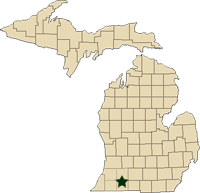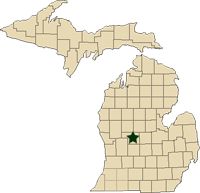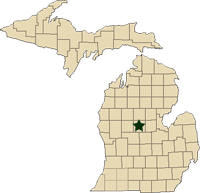Regional reports on Michigan field crops – April 26, 2012
MSU Extension educators’ pest and field crop updates for Michigan.
This week’s regional reports:
- Southwest Michigan – Bruce Mackellar
- West Central Michigan – Fred Springborn
- Central Michigan – Paul Gross
Southwest Michigan – Bruce Mackellar, Michigan State University Extension
|
Weather
Conditions have been cool, dry and windy over the past week. Rainfall on April 25 brought widespread totals around 0.25 inches. Field conditions prior to yesterday’s (April 25) rain had dried enough for field operations to resume (following last weekend’s rainfall). Cold, nighttime temperatures (with several light frosts) continue to keep soil temperatures around the 50°F mark. Planting for corn and soybeans has resumed, but the cold conditions have kept many growers wondering if they should wait a bit to put the majority of their corn and soybeans in the ground.
Rainfall totals from this storms across the 13 stations in southwest Michigan averaged 0.55 inches over the last seven days. Overall, soil moisture remains favorable for field work. Average precipitation across the region is down about 0.5 inches over the last four weeks compared to the longer term normal. The 6-10 day outlook from NOAA have southwest Michigan in the above average precipitation range, while the 8-14 day outlook shows drier than normal conditions.
Growing degree days (GDD). We are currently averaging 571 GDDs base 41 since March 1in the southwest region. We generally suggest harvesting first cutting alfalfa around the 750 GDD mark for top quality dairy forage. We have accumulated on average 51 GDDs base 50 since April 15. It generally takes around 125 GDDs base 50 for corn to emerge. Our longer term average for the region is about 4.5 GDDs per day base 50 over this time period. The 6-10 day temperature outlook from NOAA has southwest Michigan in the normal range, but the 8-14 day outlook is suggesting an increase of temperatures to above normal.
Commodity reports
Wheat growth continues to be ahead of schedule, although growth rate has slowed. My reference field at home is still at Feeke’s Stage 7 (second node just visible). Leaf disease pressure is light at this point. Each year, we have a few growers that plant second crop of soybeans following wheat. If the wheat crop continues to progress ahead of schedule, this might be a good year to try this. The earlier the soybeans are planted the better. Wheat harvest around the last week of June to the first week of July is the most optimal. Irrigation to ensure rapid germination and emergence is also a big help. The southern counties have the best track record of being able to producing second crop soybeans.
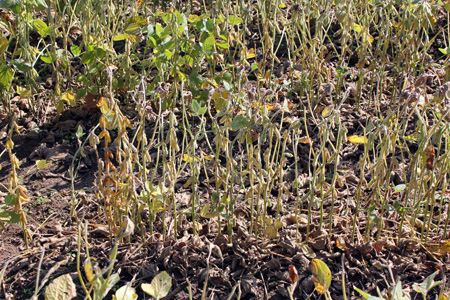
Second crop beans
Alfalfa growth has slowed considerably following frosts and cold temperatures. You can find alfalfa weevil larvae in a good number of fields, but damage is well below threshold levels in fields that I have walked. Thresholds pre-harvest are 40 percent of stems damaged, plus live larvae present.
Corn and soybeans. Planting continues for both corn and soybeans. Progress for commercial corn may be in the 20 to 30 percent range in St. Joseph County. Lots of questions continue about the impact of cold soil temperatures at the time of planting. The southwest regional report on April 19 discusses some of the implications. Some of the earliest planted corn has emerged. I have not seen soybeans emerged yet in fields I have driven past.
We have four black cutworm wing traps up in southern and central Van Buren County with only one moth caught at this time. Purdue reports that southern Indiana had record moth catches in late March. I am still concerned that the strong push of warm wind from the south around April 15 may have moved moths into our area. Populations can be very localized and hard to find with the few traps we have. Fields that had winter annual weeds around April 15 could be susceptible to infestations. Growers should be aware that moths might have made their way to Michigan in late March. This is a pest to keep in your mind early this season. I would also caution growers to keep an eye out for unusual numbers of white grubs as tillage and planting operations are conducted. Asiatic garden beetles are on the increase throughout southwest Michigan, and have caused widely scattered stand losses severe enough to force re-planting in a few fields.
Stand diagnostics. As we begin walking fields evaluating stands, there are several things we can look for to help diagnose problems. Last season we saw a lot of uneven emergence in fields. This can occur because of variable soil moisture levels, soil temperatures and uneven seed placement depth. Poor seed to soil contact (clods, partially open seed channel) as well as sidewall compaction of seed channel can also be factors. Soil insects can also cause challenges. Wireworms (mostly on fields rotated from sod) and seed corn maggots (usually less of a problem since we have insecticide-treated seeds) can feed on seed before or shortly after germination. Crusting can cause challenges with emergence, and can lead to seedling leafing out underground. Cold soil temperatures can also cause seedlings to leaf out underground or exhibit the corkscrew symptoms.
As frost and freeze advisories are still in the forecast over the upcoming weekend, we could still be in for more damage to early emerged corn. The growing point is well below the soil surface, but repeated exposure to cold temperatures can take a toll on seedlings.
West Central Michigan – Fred Springborn, Michigan State University Extension
|
Weather
Rain showers on April 15-16 yielded over an inch of rain and somewhat lighter showers again on April 20 slowed field work in the past two weeks. Field work on most farms is far ahead of normal due to the generally dry conditions this spring. A good deal of spring tillage has already occurred and as soon as soils warm back up, planting progress should occur very rapidly. At the 2-inch level, low soil temperatures are in the mid- to low 40s°F at Entrican and Fremont, Mich. High air temperatures are in the 50s to low 60s with lows dipping into the high 20s to mid-30s most nights.
In pheromone traps this week we are catching low levels of armyworm moths, one per trap, and so far have not caught any black cutworm moths. Both of these pests are migratory and arrive in the state by being blown in on storm fronts – they do not overwinter in Michigan. Even though I am catching low numbers in my traps, scouting will still be necessary for these pests as populations can vary greatly from one location to another.
High winds have caused some significant wind erosion on a number of fields in the region. Fields that have seen the most erosion and blowing soil are coarse-textured soils that had no cover crop in place. While generally dry soil conditions are a contributing factor, there is a notable difference in erosion on fields with no cover crop, and those where a cover crop existed. Even where the cover crop had been killed or tilled into the soil, or where crop residue is present, far less soil erosion has been observed.
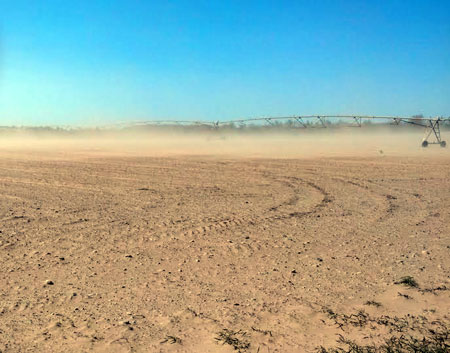
Bare field with no cover crop and very little crop residue in Montcalm County.
Crops
Corn planting is underway, but many producers are recognizing it is still early on the calendar and are waiting for warmer soil temperatures and weather.
Alfalfa is variable in growth and frost and freeze injury. It is time to start scouting for alfalfa weevil.
Wheat is in Feekes 6 with some fields in Feekes 7. Leaf diseases are minimal at this time. We are seeing a number of fields with burned leaf tips in some cases from low temperatures and frost and freeze injury, and in other cases from fertilizer burn.
Oat stands are generally good with many in Feekes stage 5.
Sugarbeets are emerging with generally good stands. Wind damage is evident in some fields.
Central Michigan – Paul Gross, Michigan State University Extension
|
Weather
Areas of the region received over an inch of much needed rain in the past two weeks. Soil moisture is still considered short on many of the lighter soils for this time of year. Soil temperatures are beginning to creep up to near 50 degrees. The region is still experiencing below freezing temperatures on many mornings. The cool temperatures have limited crop growth. The warmer weather predicted next week along with the calendar will get the planter rolling.
Commodity reports
Corn planting is well underway in the south parts of the region and just getting started in the north. With the warm weather expected next week, everyone will be planting and taking advantage of good field conditions. It is expected that the crop will be planted very fast this year because most tillage is already completed. It is estimated that about 10 percent of the crop is planted.
The wheat crop is in Feeke’s growth stage 6-7. The crop is recovering from several frosty mornings. Most of the herbicide and nitrogen applications have been made. Many fields show yellowing and less than ideal color. Much of this is due to cool temperatures. We still have many variable stands. Warm weather should bring most fields around. Yield potential is still considered very good at this time.
Oats are all planted and most have emerged. Some frost damage has been observed, but last week’s rain and warmer weather is helping the crop recover. Alfalfa seeded with oats is emerged and doing great.
Alfalfa has recovered from the frost-damaged tips of two weeks ago. Growth has slowed because of the cool temperatures. Fields should be scouted for alfalfa weevil. There are no reports of weevil at this time.
Sugarbeets are all planted and emerging with no reported problems.



 Print
Print Email
Email